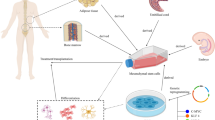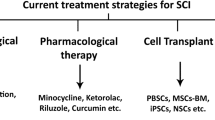Abstract
Injury-induced neuropathic pain remains a serious clinical problem. Recent studies indicate that bone marrow stromal cells (BMSCs) effectively attenuate chronic neuropathic pain in animal models. Here, we examined the therapeutic effect of intrathecal administration of BMSCs isolated from young (1-month-old) rats on pain hypersensitivity induced by tibial nerve injury. Cerebrospinal fluid (CSF) was collected and analyzed to examine the effect of BMSC administration on the expression of 67 soluble factors in CSF. A sustained remission in injury-induced mechanical hyperalgesia was observed in BMSC-treated rats but not in control animals. Engrafted BMSCs were observed in spinal cords and dorsal root ganglia at 5 weeks after cell injection. Injury significantly decreased the levels of six soluble factors in CSF: intercellular adhesion molecule 1 (ICAM-1), interleukin-1β (IL-1β), IL-10, hepatocyte growth factor (HGF), Nope protein, and neurogenic locus notch homolog protein 1 (Notch-1). Intrathecal BMSCs significantly attenuated the injury-induced reduction of ICAM-1, IL-1β, HGF, IL-10, and Nope. This study adds to evidence supporting the use of intrathecal BMSCs in pain control and shows that this effect is accompanied by the reversal of injury-induced reduction of multiple CSF soluble factors. Our findings suggest that these soluble factors may be potential targets for treating chronic pain.





Similar content being viewed by others
References
Abdel Aziz MT et al (2013) Effect of mesenchymal stem cells and a novel curcumin derivative on Notch1 signaling in hepatoma cell line. Biomed Res Int 2013:129629
Aggarwal S, Pittenger MF (2005) Human mesenchymal stem cells modulate allogeneic immune cell responses. Blood 105:1815–1822
Backonja MM et al (2008) Altered cytokine levels in the blood and cerebrospinal fluid of chronic pain patients. J Neuroimmunol 195:157–163
Bara JJ et al (2014) Bone marrow-derived mesenchymal stem cells become antiangiogenic when chondrogenically or osteogenically differentiated: implications for bone and cartilage tissue engineering. Tissue Eng Part A 20:147–159
Basbaum AI et al (2009) Cellular and molecular mechanisms of pain. Cell 139:267–284
Batten P et al (2006) Human mesenchymal stem cells induce T cell anergy and downregulate T cell allo-responses via the TH2 pathway: relevance to tissue engineering human heart valves. Tissue Eng 12:2263–2273
Beyth S et al (2005) Human mesenchymal stem cells alter antigen-presenting cell maturation and induce T-cell unresponsiveness. Blood 105:2214–2219
Brierley JB, Field EJ (1948) The connexions of the spinal sub-arachnoid space with the lymphatic system. J Anat 82:153–166
Chaplan SR et al (1994) Quantitative assessment of tactile allodynia in the rat paw. J Neurosci Methods 53:55–63
Chen G et al (2015) Intrathecal bone marrow stromal cells inhibit neuropathic pain via TGF-beta secretion. J Clin Investig 125:3226–3240
Clark AK, Old EA, Malcangio M (2013) Neuropathic pain and cytokines: current perspectives. J Pain Res 6:803–814
Crisostomo PR et al (2008) Human mesenchymal stem cells stimulated by TNF-alpha, LPS, or hypoxia produce growth factors by an NF kappa B—but not JNK-dependent mechanism. Am J Physiol Cell Physiol 294:C675–C682
Decosterd I, Woolf CJ (2000) Spared nerve injury: an animal model of persistent peripheral neuropathic pain. Pain 87:149–158
Del Papa B et al (2013) Notch1 modulates mesenchymal stem cells mediated regulatory T-cell induction. Eur J Immunol 43:182–187
Dixon WJ (1980) Efficient analysis of experimental observations. Annu Rev Pharmacol Toxicol 20:441–462
Dominici M et al (2006) Minimal criteria for defining multipotent mesenchymal stromal cells. The International Society for Cellular Therapy position statement. Cytotherapy 8:315–317
Franchi S et al (2012) Intravenous neural stem cells abolish nociceptive hypersensitivity and trigger nerve regeneration in experimental neuropathy. Pain 153:850–861
Guo W et al (2011) Bone marrow stromal cells produce long-term pain relief in rat models of persistent pain. Stem Cells 29:1294–1303
Himango WA, Low FN (1971) The fine structure of a lateral recess of the subarachnoid space in the rat. Anat Rec 171:1–19
Hofmann HA et al (2003) Pharmacological sensitivity and gene expression analysis of the tibial nerve injury model of neuropathic pain. Eur J Pharmacol 470:17–25
Hogan Q et al (2004) Detection of neuropathic pain in a rat model of peripheral nerve injury. Anesthesiology 101:476–487
Hosseini M et al (2015) The effect of bone marrow-derived mesenchymal stem cell transplantation on allodynia and hyperalgesia in neuropathic animals: a systematic review with meta-analysis. Biol Blood Marrow Transplant 21:1537–1544
Jacobs SA et al (2013) Immunological characteristics of human mesenchymal stem cells and multipotent adult progenitor cells. Immunol Cell Biol 91:32–39
Kessler JA et al (2015) Double-blind, placebo-controlled study of HGF gene therapy in diabetic neuropathy. Ann Clin Transl Neurol 2:465–478
Kucerova L et al (2010) Tumor cell behaviour modulation by mesenchymal stromal cells. Mol Cancer 9:129
Kwilasz AJ et al (2015) The therapeutic potential of interleukin-10 in neuroimmune diseases. Neuropharmacology 96:55–69
Labuz D et al (2009) Immune cell-derived opioids protect against neuropathic pain in mice. J Clin Invest 119:278–286
Ledeboer A et al (2007) Intrathecal interleukin-10 gene therapy attenuates paclitaxel-induced mechanical allodynia and proinflammatory cytokine expression in dorsal root ganglia in rats. Brain Behav Immun 21:686–698
Lee MW et al (2015) Strategies to improve the immunosuppressive properties of human mesenchymal stem cells. Stem Cell Res Ther 6:179
Liang X et al (2014) Paracrine mechanisms of mesenchymal stem cell-based therapy: current status and perspectives. Cell Transplant 23:1045–1059
Liu L, Duff K (2008) A technique for serial collection of cerebrospinal fluid from the cisterna magna in mouse. J Vis Exp JoVE 21:960. doi:10.3791/960
Machelska H et al (2002) Opioid control of inflammatory pain regulated by intercellular adhesion molecule-1. J Neurosci 22:5588–5596
Mackenzie TC, Flake AW (2001) Human mesenchymal stem cells persist, demonstrate site-specific multipotential differentiation, and are present in sites of wound healing and tissue regeneration after transplantation into fetal sheep. Blood Cells Mol Dis 27:601–604
Mao F et al (2010) Immunosuppressive effects of mesenchymal stem cells in collagen-induced mouse arthritis. Inflamm Res 59:219–225
Meirelles Lda S et al (2009) Mechanisms involved in the therapeutic properties of mesenchymal stem cells. Cytokine Growth Factor Rev 20:419–427
Meyerrose T et al (2010) Mesenchymal stem cells for the sustained in vivo delivery of bioactive factors. Adv Drug Deliv Rev 62:1167–1174
Milligan ED et al (2006) Intrathecal polymer-based interleukin-10 gene delivery for neuropathic pain. Neuron Glia Biol 2:293–308
Nadeau S et al (2011) Functional recovery after peripheral nerve injury is dependent on the pro-inflammatory cytokines IL-1beta and TNF: implications for neuropathic pain. J Neurosci 31:12533–12542
Pittenger MF et al (1999) Multilineage potential of adult human mesenchymal stem cells. Science 284:143–147
Pleticha J et al (2015) High cerebrospinal fluid levels of interleukin-10 attained by AAV in dogs. Gene Ther 22:202–208
Ren G et al (2010) Inflammatory cytokine-induced intercellular adhesion molecule-1 and vascular cell adhesion molecule-1 in mesenchymal stem cells are critical for immunosuppression. J Immunol 184:2321–2328
Salbaum JM, Kappen C (2000) Cloning and expression of nope, a new mouse gene of the immunoglobulin superfamily related to guidance receptors. Genomics 64:15–23
Schafer S et al (2014) Influence of intrathecal delivery of bone marrow-derived mesenchymal stem cells on spinal inflammation and pain hypersensitivity in a rat model of peripheral nerve injury. J Neuroinflamm 11:157
Shibata T et al (2008) Transplantation of bone marrow-derived mesenchymal stem cells improves diabetic polyneuropathy in rats. Diabetes 57:3099–3107
Siniscalco D et al (2010) Intra-brain microinjection of human mesenchymal stem cells decreases allodynia in neuropathic mice. Cell Mol Life Sci CMLS 67:655–669
Sun YY et al (2012) The spinal notch signaling pathway plays a pivotal role in the development of neuropathic pain. Mol Brain 5:23
Temporin K et al (2008) Interleukin-1 beta promotes sensory nerve regeneration after sciatic nerve injury. Neurosci Lett 440:130–133
Tolar J et al (2010) Concise review: hitting the right spot with mesenchymal stromal cells. Stem Cells 28:1446–1455
Tran C, Damaser MS (2015) Stem cells as drug delivery methods: application of stem cell secretome for regeneration. Adv Drug Deliv Rev 82–83:1–11
Tsuchihara T et al (2009) Nonviral retrograde gene transfer of human hepatocyte growth factor improves neuropathic pain-related phenomena in rats. Mol Ther 17:42–50
von Hehn CA, Baron R, Woolf CJ (2012) Deconstructing the neuropathic pain phenotype to reveal neural mechanisms. Neuron 73:638–652
Wehner R et al (2009) Mesenchymal stem cells efficiently inhibit the proinflammatory properties of 6-sulfo LacNAc dendritic cells. Haematologica 94:1151–1156
Wen L et al (2014) Immunomodulatory effects of bone marrow-derived mesenchymal stem cells on pro-inflammatory cytokine-stimulated human corneal epithelial cells. PLoS One 9:e101841
Wu HE et al (2010) Learned avoidance from noxious mechanical simulation but not threshold semmes weinstein filament stimulation after nerve injury in rats. J Pain 11:280–286
Xie K et al (2015) Notch signaling activation is critical to the development of neuropathic pain. BMC Anesthesiol 15:41
Xu Q et al (2013) Intrathecal transplantation of neural stem cells appears to alleviate neuropathic pain in rats through release of GDNF. Ann Clin Lab Sci 43:154–162
Yu H et al (2011) Lentiviral gene transfer into the dorsal root ganglion of adult rats. Mol Pain 7:63
Yu H et al (2015) Analgesia for neuropathic pain by dorsal root ganglion transplantation of genetically engineered mesenchymal stem cells: initial results. Mol Pain 11:5
Acknowledgements
This work was supported by grant from the National Institute of Neurological Disorders and Stroke (R01NS079626-01) to QHH. Authors thank Zhen Liu for assistance in histological sample preparation.
Author information
Authors and Affiliations
Contributions
HY and QHH contributed to conception and design of the study; GF, HY, and QHH helped in performing experiments, collection and/or assembly of data, data analysis and interpretation, and manuscript writing; FW and HX performed experiments and data analysis; XB helped with consultant.
Corresponding authors
Ethics declarations
Conflict of interest
The authors indicated no potential conflicts of interest.
Electronic supplementary material
Below is the link to the electronic supplementary material.
221_2017_5000_MOESM1_ESM.xlsx
Supplementary Table 1. Complete results of antibody array. Mean concentration of each soluble factor in CSF (n = 5 for each group) with SEM. (XLSX 13 kb)
Rights and permissions
About this article
Cite this article
Fischer, G., Wang, F., Xiang, H. et al. Inhibition of neuropathic hyperalgesia by intrathecal bone marrow stromal cells is associated with alteration of multiple soluble factors in cerebrospinal fluid. Exp Brain Res 235, 2627–2638 (2017). https://doi.org/10.1007/s00221-017-5000-x
Received:
Accepted:
Published:
Issue Date:
DOI: https://doi.org/10.1007/s00221-017-5000-x




